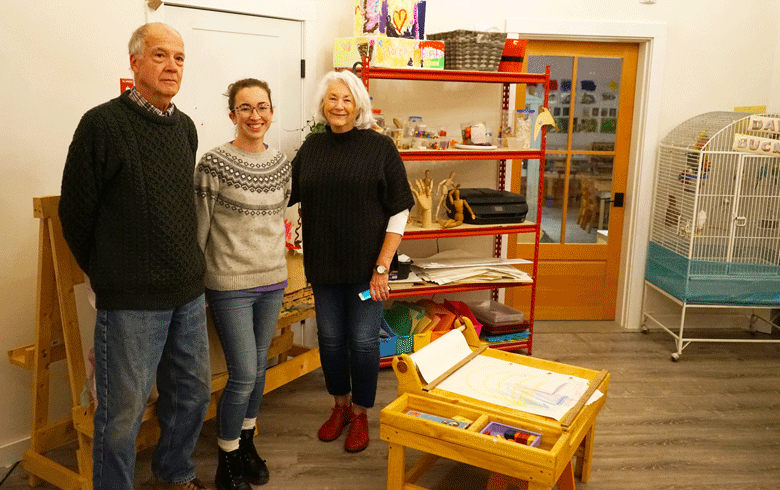In the December/January issue, the Rock Bound column included observations about the nonprofit childcare center created in Castine by mostly volunteer efforts. We felt the success of this endeavor was worthy of its own story.
In 2017, a couple of college professors from Pennsylvania who retired to Castine found a way to contribute to their new community. The story then was that the childcare facility they wanted to establish would rise from a century old, in-ground water tank that had served the village downhill.
Today, the story is how the vision became reality and how the Community Childhood Learning Place is providing a safe, engaging environment for the children of working parents.
The facility, like the tank before it, is circular. A wide, welcoming entrance with painted murals depicting the four seasons leads to doors that open on a conference room, an office, and then to the slice-of-pie-shaped rooms where children gather according to age range.
The building contains about 4,000 square feet of floor space. In the center “studio” room, ideal for children’s art projects, the ceiling rises in a soaring cone shape with a chandelier near the peak.
In the center “studio” room, ideal for children’s art projects, the ceiling rises in a soaring cone shape…
Despite the architectural grandeur, there’s no fussiness or institutional sterility. I visited in the evening, shortly after the last child had been picked up by a parent, and the building looked very much like a small elementary school, with large volumes of educational and activity materials loosely organized on shelves and tables, and notes, lists, and instructions on the walls.
Nancy Sayre, a retired professor who taught early childhood development, was the driving force behind the center and she now holds the title of executive director.
Her husband W.G. Sayre, a retired chemistry and physics professor, ended up as volunteer project supervisor. He estimates the building would have cost three times more if it hadn’t relied on some 50 volunteers.
Help also came in generosity from professionals and tradespeople, including: architectural services from Tim Mohr and Sherman Todd, plumbing and electrician work billed lower than bids, concrete from Wardwell Construction at wholesale price, and a 21 percent discount on materials from Hammond Lumber. The architects even persuaded window manufacturer Pella to discount its products for the project.
The building has 8-inch-thick walls providing excellent insulation, W.G. said., and it heats well with a high-efficiency propane boiler. The building used most of the original stone foundation. While it was being improved, workers found a cannonball embedded in the stones, a testament to Castine’s long history of military battles.
Director Ren Albon is assisted by a staff of four. She explains that the Reggio Emillia approach is used, which the center’s website describes as focused on “the image of the child,” with teachers observing the children interacting with the environment and asking questions.
“Through the use of natural materials, paint, chalk, crayons, clay, drama, music, and light table the children will develop knowledge and skills about topics related to their interests. The indoor and outdoor learning environment revolves around the child,” the website explains.
The center opened on Dec. 2, 2019, and, when the pandemic hit, closed three months later. It is again operational, and serves 28 at full capacity, opening at 7:30 a.m. for children too young for school and closing at 5 p.m. Currently, the age range is from three months to nine-years old.
COVID has lent an urgency to the work, Nancy Sayre said, since many private daycare centers have closed. The answer, she asserts, is “small communities stepping up.”
She is blunt about what is available to most families.
“Most daycare is mediocre to poor,” says Sayre, and she is clearly proud of the level of thought that guides programming at the Community Childhood Learning Place. It’s being reviewed for accreditation by the National Association for the Education of Young Children.
Albon says the center runs well with no real behavior problems.
“The space makes a big difference,” she says. “Circular buildings are calming.” The well-structured environment also helps. Children arriving from Castine’s nearby Adams School are asked to spend the first hour on homework, but other, non-school like activities abound, like sitting on yoga mats while music plays and simple meditation exercises.
“They know the expectations. They know what they need to do,” Albon said.
The older children have jobs that rotate. The names are posted on the wall next to the job: sous chef, librarian, mammologist, kindness.
Though it’s a nonprofit, the center charges $195-$225 for all-day attendance, depending on age, and $75 a week for three hours a day, including a snack. The national average tuition for such daycare is $10,000, Sayre said. The center’s annual budget is $225,000 and if an endowment is established, the hope is to offer scholarships.
“All the parents are working,” W.G. points out.
The center draws from families from Castine, Penobscot, Orland, Blue Hill, Bucksport, and Brooksville.





